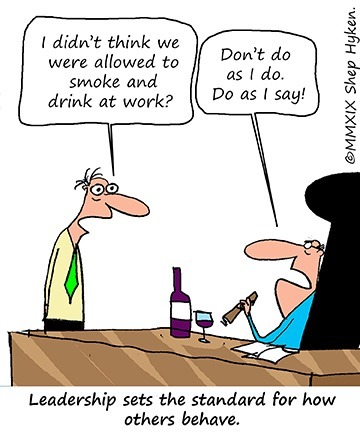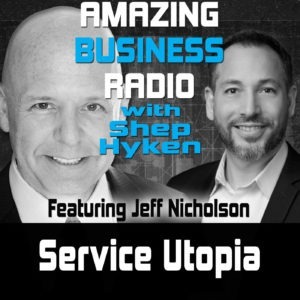Shep Hyken's Blog, page 128
April 22, 2019
5 Top Customer Service Articles for the Week of April 22, 2019
Each week I read a number of customer service and customer experience articles from various resources. Here are my top five picks from last week. I have added my comment about each article and would like to hear what you think too.
Why Anxious Customers Prefer Human Customer Service by Michelle A. Shell and Ryan W. Buell
(HBR) It is clear that these technologies are less expensive to offer than human support. But what’s less clear is the toll these self-service interactions may take on customers.
My Comment: Here is an interesting topic: Customer Anxiety. The authors (from Harvard) explore how anxious customers are more desiring of human-to-human support. Using self-service options in high-anxiety settings can negatively impact the customer experience and erode confidence in the form of diminished trust with the company that the customer is interacting with.
Service Transformation Must Come From the C-Suite by Dr. Natalie Petouhoff
(Salesforce) Did you know many customer service departments are still in dinosaur mode? They face shifting demands from customers without the necessary tools, strategy, processes, and agents’ skills to meet them.
My Comment: If you want the service culture in an organization to change, it must start at the top with leadership. As Bill Patterson, Salesforce Service Cloud’s GM and Executive VP would say, “Never before has it been more important to rid the world of bad customer service experiences.” Leadership must recognize that service transformation is a “competitive must” and a strategic asset.
Top-Rated in Employee Engagement and Customer Satisfaction: How does Quicken Loans do it? by Mohamed Latib, Ph.D.
(CX University) Quicken Loans has innovated a process for delivering continual change while providing a stable cultural structure. It is elegantly simple, and it works splendidly.
My Comment: It’s always interesting to compare these two lists, as many times the companies featured as one of the best places to work are also found on the top ranked customer service company lists. This article is an interesting case study on Quicken Loans, who have found themselves on both lists. And, it isn’t surprising that success appears to start on the inside with a high level of customer engagement.
10 Fresh Examples Of Customer Experience Innovation by Blake Morgan
(Forbes) Here are 10 fresh examples of CX innovation from brands that aren’t afraid to think outside the box to serve customers.
My Comment: Innovation in customer service and CX is increasing as companies recognize the competitive advantage it gives them. Some companies take that to the extreme, and that’s not a bad thing. Here is a list of how ten companies are using innovation to be competitive, and in some cases (potentially) disrupting their industries.
5 Awesome Ways To Improve Your CSAT Survey Response Rates by Catherine Heath
(Nicereply) We’re in a new era of customer surveys – they should be fun to complete, visually appealing, simple and easy.
My Comment: Do you want your customer surveys answered? Here are five ways to drive better response rates. While none of them should surprise you, what is surprising is that more companies haven’t adopted these strategies.
Shep Hyken is a customer service expert, professional speaker and New York Times bestselling business author. For information on The Customer Focus customer service training programs go to www.TheCustomerFocus.com. Follow on Twitter: @Hyken
customer service training programs go to www.TheCustomerFocus.com. Follow on Twitter: @Hyken
The post 5 Top Customer Service Articles for the Week of April 22, 2019 appeared first on Shep Hyken.
April 19, 2019
Guest Blog: The Art of the Survey – Why one question is more than enough
This week we feature an article by Georgina Nelson who explains her approach to collecting customer feedback that will help you provide a better customer experience.
One of the biggest misconceptions about collecting customer feedback is the idea that asking more questions provides more of the insights you’re looking for. Through our work with retail businesses across the world, we’ve found that this couldn’t be further from the truth.
While it may be tempting to ask a customer to fill out a survey before they leave your store or solicit feedback online with an incentive on their receipts, there’s a reason those methods tend to fall short on capturing meaningful insights. In many cases, the response rates are extremely low because customers simply don’t have the time or desire to take a survey. And when customers do respond, you run the risk of only hearing from those who complete the survey to earn the incentive, which can diminish the accuracy of their responses.
With short attention spans and little patience for anything that may slow down the shopping experience or infringe on free time later, many shoppers aren’t looking to fill out extensive surveys for businesses. In fact, roughly 80% of consumers believe the most important part of good service is the ability for a company to respect their time.
Striking the delicate balance of garnering feedback from customers without negatively impacting their experience can be challenging – but the good news is that it’s not impossible.
Taking a “less is more” approach to how you collect feedback can help you gain accurate and powerful customer insights.
The Power of One Question
As few as two percent of customers will take the time to complete a survey. Couple that with the fact that the average person gets distracted in just eight seconds, and it becomes clear why collecting customer feedback can be so tough.
Rather than bombarding customers with lots of questions, try limiting your interactions to just one question. By asking customers one specific question about their experience, you can significantly increase the chances that they will actually provide feedback. Research from TruRating shows that a one-question survey at the point of sake can result in a 90% in-store response rate.
Why Simple is Sometimes Best
Asking one question per customer opens the door for you to take a deeper dive into what’s driving behaviors and preferences. Wondering if that new promotion is actually driving sales? If the latest change to your store layout is helping shoppers find what they need more quickly? A simple, straightforward question can provide actionable results, in quick measure. Make life easier for the customer, and they’ll naturally respond with positive appreciation.
By rotating questions on a customer by customer basis, you can ensure you’re collecting responses on a wide variety of issues. Whether that means identifying
the days that customers receive the best service or understanding which of your marketing channels are driving the most revenue, valuable information can be captured quickly through a single question.
If you can provide a simple multiple-choice selection, or intuitive rating request at payment, even better. By enabling customers to give feedback in the moment, in a matter of seconds, you avoid the risk of tainting an otherwise good experience with unwanted follow-ups. The customer experience doesn’t end with the transaction – every step of the journey, whether in or out of the store, have a cumulative impact on customer perception.
Collecting feedback while satisfying the modern consumer’s expectations for speed and convenience isn’t easy – but it can be done. By simplifying the process, and integrating it seamlessly into your existing customer journey, you can quickly achieve results that meet both your and your customers’ needs.
 Georgina Nelson, founder and CEO of TruRating, has brought together a wonderful team, exciting customers and partners in the payments industry with the ultimate objective to bring the truth back to ratings.
Georgina Nelson, founder and CEO of TruRating, has brought together a wonderful team, exciting customers and partners in the payments industry with the ultimate objective to bring the truth back to ratings.
For more articles from Shep Hyken and his guest contributors go to customerserviceblog.com.
Read Shep’s latest Forbes article: Burger King Serves Up Subscription Coffee
The post Guest Blog: The Art of the Survey – Why one question is more than enough appeared first on Shep Hyken.
April 17, 2019
Experiential Calluses Against Poor CX
 Last summer I played golf with a friend. At the end of the game, he had blisters. He didn’t play very often, and the golf clubs rubbed his skin raw. My hands were just fine. I’m fortunate to play several times a month and over time I’ve built up calluses that prevent those nasty blisters. It’s simple. The more a person plays, the thicker the calluses get, which immunizes people against blisters and pain.
Last summer I played golf with a friend. At the end of the game, he had blisters. He didn’t play very often, and the golf clubs rubbed his skin raw. My hands were just fine. I’m fortunate to play several times a month and over time I’ve built up calluses that prevent those nasty blisters. It’s simple. The more a person plays, the thicker the calluses get, which immunizes people against blisters and pain.
That brings us to a dinner I recently attended where I met Terry Rapoch, a consultant from Dayton, Ohio. We were talking about why people put up with bad service – especially service that is inconvenient and has friction. He called it an experiential callus. There may be a little pain, but you get used to it and put up with it. In certain situations, for certain products, it’s just easier to deal with the pain than switch to a different company.
For example, switching banks isn’t easy. Changing software can be very painful. So, a customer might tolerate a certain amount of pain in the form of poor service or friction and live with it until it becomes so bad they feel forced to switch.
The type of business that keeps customers by making it difficult to leave is known as a sticky business. Sticky, because it’s not easy to switch. It may take a lot of time and effort. It may be, metaphorically speaking, painful to switch.
I once met an executive of a software company who openly admitted that his company didn’t have to provide the best support, but barely adequate support. He knew it was difficult for his customers to learn a new software program, so the bare minimum effort was all he needed to keep his customers.
That may work in the short term, but eventually, a competitor will see the opportunity. That’s why Richard Branson started Virgin Air. He didn’t like the way big airlines treated customers. He said they were taking the mickey out on the customer. That’s British slang, and roughly translated it means having a joke at the customer’s expense. In business, that means not giving the customer a good value for their money. Customers may have built up tolerance in the form of an experiential callus to the way the airlines treated them. Then they realized they had a choice—and started flying Virgin Air.
It’s not always easy to change when you’re used to something, even when you experience a little pain and know there might be a better alternative. That callus gets pretty thick. But trust me; there will be many Richard Branson-types out there, looking for opportunities to capitalize on the experiential callus and finding ways to give customers a better experience.
Shep Hyken is a customer service expert, keynote speaker, and New York Times bestselling business author. For information, contact 314-692-2200 or www.hyken.com. For information on The Customer Focus customer service training programs, go to www.thecustomerfocus.com. Follow on Twitter: @Hyken
customer service training programs, go to www.thecustomerfocus.com. Follow on Twitter: @Hyken
The post Experiential Calluses Against Poor CX appeared first on Shep Hyken.
April 16, 2019
Amazing Business Radio: Sandy Rogers
 Lead with Loyalty with Guest Sandy Rogers
Lead with Loyalty with Guest Sandy RogersEnhancing the Customer Experience Through Emotional Engagement
Shep Hyken interviews Sandy Rogers. They discuss his new book, Leading Loyalty: Cracking the Code to Customer Devotion, and the importance of empathy, responsibility, and generosity in the customer experience.








The Interview with Sandy Rogers:
During Sandy’s tenure at Enterprise Rent-a-Car, the company focused on improving customer service to drive loyalty. They measured service quality and strove to improve from the bottom up. Over ten years, the company’s customer satisfaction rating grew from 67% to 80%, service quality became more consistent between all branches, and sales tripled. The employees may have stayed the same, but changes in management and expectation directly lead to the improvement.
The biggest factor in customer loyalty is empathy. Loyalty is an emotion that can’t always be explained by numbers and figures. Companies need to remember to include the human element when dealing with their customers if they hope to win their hearts, which is the key to winning their business.
Empathy and emotional engagement begin inside the company within the employee experience. Companies must respect and empathize with their employees if they want and expect their employees to do the same with their customers. What is felt on the inside of an organization will be felt on the outside.
Implement a regular “loyalty huddle” with your team. Use this time to focus on one of the principles of loyalty outlined in the book, such as empathy, responsibility, or generosity. Celebrate successes and create a safe space to discuss things that aren’t working and ideas for improvement.
Empower your employees to come up with ideas for improvement and to deliver the best level of customer service they can, even if that means deviating from established policies. It falls to management to lead this charge and advocate for change. Allow good ideas to come from every level of employee, from frontline representative to CEO.
Loyalty programs and rewards points may help with customer loyalty, but they’re too easy for competitors to copy. At the end of the day, loyalty will be more driven by empathy and customers’ emotional engagement with a company.
There will always be people who will try to cheat the system and take advantage of you. You can’t let those few dictate your business practices, because you will alienate the rest of your customers and lose their loyalty by being difficult to work with. This will only end up hurting your company in the end.
As a leader, you must choose to center your company’s culture around the principles of loyalty. Reward and demonstrate the practices you value as central to your goal. You will start to see positive changes not only in your business but also in your personal life.
Quotes:
“Empathy doesn’t come from scripts. It comes from designing an environment that allows it.” – Sandy Rogers
“We must start by earning the fierce loyalty of our employees by treating them with empathy, responsibility, and generosity.” – Sandy Rogers
“Leadership is a choice. You need to choose to be a loyalty leader.” – Sandy Rogers
About:
Sandy Rogers is the co-author of Leading Loyalty: Cracking the Code to Customer Devotion and the leader of FranklinCovey’s Loyalty Practice. Formerly, Sandy was the senior vice president at Enterprise Rent-A-Car.
Shep Hyken is a customer service and experience expert, New York Times bestselling author, award-winning keynote speaker, and your host of Amazing Business Radio.
This episode of Amazing Business Radio with Shep Hyken answers the following questions … and more:
How can I create customer loyalty?
What drives customer loyalty?
How is the employee experience related to the customer experience?
How do I change my company’s culture?
How important is empathy in creating loyalty?
The post Amazing Business Radio: Sandy Rogers appeared first on Shep Hyken.
April 15, 2019
5 Top Customer Service Articles for the Week of April 15, 2019
Each week I read a number of customer service and customer experience articles from various resources. Here are my top five picks from last week. I have added my comment about each article and would like to hear what you think too.
6 Customer Service Pitfalls and How to Avoid Them by Sam Del Rowe
(destinationCRM.com) Though the two terms are often used interchangeably, customer service and customer experience are not the same thing, Forrester Research asserts in a new report.
My Comment: This article is an interpretation of a Forrester report focused on customer service and customer experience. Riccardo Pasto, the senior analyst of CX at Forrester, identified a number or “pitfalls” that can potentially apply to almost any business. This is a nice recap of that info and good “food for thought.”
How to create a customer experience that keeps bringing people back by Joe Schultz
(Retail Customer Experience) Delivering an exceptional customer experience in the retail space requires more than a great product. Much more. In fact, in the discovery phase of CX design, your product or service is probably the least important factor to consider.
My Comment: Want your customers to keep coming back? Let’s take some lessons from the retail industry. I especially like idea number two, which is to show the customer their future with your product or service. In short, what would it look like if they bought what you sell? Give them the experience of learning/seeing how buying from you will benefit them.
Why service staff avoid taking ownership – and how to help them by Jeff Toister
(MyCustomer) Customer service staff often deflect problems when they believe the issue was someone else’s fault. But customers don’t want blame – they want the problem solved. So how can organisations ensure their service staff has an ownership mindset?
My Comment: There are many things that could frustrate a customer when they have a problem or complaint. One of them is when the customer service rep casts blame on someone else. I’ve always believed the philosophy that “It may not be my fault, but it is my opportunity to resolve the issue and make the customer happy.” As the author points out, customers don’t want blame. They want the problem solved. Here are some suggestions on how to get your team to take ownership of their customers problems.
New Study: Customer Service in the Age of Artificial Intelligence by David Wang
(Zingle) From Solving Problems to Saving Time — How Consumers Feel About ‘Bots’ vs Humans When it Comes to Customer Service.
My Comment: Here is a great report on how customers are warming up to chatbots and robots versus a human-to-human customer service experience. While 57% of consumers say that human customer service agents are more effective, 35% said that bots and human agents are equally effective. Interesting stats, facts and comments.
What is the future of customer service? by Anastasiia Khlystova
(Quora) The funny thing about customer service is that it’s not really changing that much. In 2019, customer service is still about listening, reacting, helping and being friendly. The only thing that is changing with customer support is technology.
My Comment: As long as we’re on the subject of chatbots (Number four in this week’s “Top Five” list), here is a glimpse into the future of customer service. Self-service, messaging and chatbots are the focus of the article. I think the future looks good!
Shep Hyken is a customer service expert, professional speaker and New York Times bestselling business author. For information on The Customer Focus customer service training programs go to www.TheCustomerFocus.com. Follow on Twitter: @Hyken
customer service training programs go to www.TheCustomerFocus.com. Follow on Twitter: @Hyken
The post 5 Top Customer Service Articles for the Week of April 15, 2019 appeared first on Shep Hyken.
April 12, 2019
Guest Blog: How to Get the Most from Seasonal Customer Service Employees
This week we feature an article by Joel Gottesman who shares tips to ensure that seasonal employees provide an excellent customer experience.
This past season, retailers hired more than 575,000 seasonal employees to help manage the holiday rush. Macy’s planned to hire 80,000 seasonal workers, while Target promised roughly 120,000 seasonal jobs. Many of these employees were tasked with challenging customer-facing positions. For example, Macy’s hired 1,500 employees at customer service call centers and countless more for sales floors across the country, while Target doubled its team dedicated to in-store pickups and curbside services. Yet, seasonal hiring is not unique to retail during the holidays. The financial services, insurance, tourism, education, and hospitality industries all rely heavily on seasonal staff to meet peak demand.
For many organizations, seasonal staff are vital to operations. However, these employees also present unique challenges to delivering exceptional customer experiences. If not properly trained and supported, the employees may fail to convert seasonal customers into year-round customers—or worse, turn off loyal customers.
The following are four quick tips for ensuring that, whether seasonal employees play a primary or complementary role in customer-facing operations, they are equipped to provide a heightened experience for all customers.
Set Realistic Expectations
Too often, seasonal employees leave jobs before the season’s end, leaving employers scrambling and operations unbalanced. Whether due to feeling overworked or underappreciated, setting realistic expectations upon hire and educating seasonal staff on their role and company mission is an effective way to control employee churn.
This may include addressing potential problem areas prior to hire, such as the need for long, sometimes unpredictable hours or overtime, a stressful and/or fast-paced environment, and the expectation to engage in tasks that they are not well-suited for or may feel is “not their job.” Light bulbs need changing, trucks need unloading, data needs inputting, bathrooms need cleaning, and customers may need help in a cold parking lot. If every team member has realistic expectations about their role, hours, pace, and job duties, it will streamline operations while cutting down on fatigue, dissatisfaction, and employee churn.
Hire for Attitude, Not Merely Competency
Even where seasonal help spends most of their time in non-customer facing positions, they will inevitably interact with customers. An employee with a negative attitude or one who is unwilling to assist is a surefire way to turn off a customer.
Look for people with positive, goal-centric attitudes whose values align with the organization and make it clear that the customer’s needs come first. A fork-lift operator can open a door for a customer and their three children, housekeeping staff can guide a guest to the pool, and a tax-preparer can answer a ringing phone politely when a receptionist is otherwise busy.
Provide FAQ Response Training and FAQ Crib Sheets

Unfortunately, it may not be cost-effective to train every seasonal employee on every facet of an organization’s business, but providing them with a handful of answers to common customer questions will limit the chance of a seasonal worker going rogue, being rude, or otherwise answering a customer with the dreaded “I don’t know.”
Every industry has different FAQs. One acceptable answer to a variety of common questions is “I’m unsure (how long your wait will be, where that product is, of the availability of that product, the difference between those two services, etc.) but I will get for you a specialist who is better equipped to assist you.” Though obvious in hindsight, politeness may not be intuitive to a seasonal employee who doesn’t appreciate an organization’s culture—especially those brought on for their technical skills. Providing training and a short FAQ Crib Sheet to an employee will reinforce the notion that assisting a customer is almost always more important than the task in front of them, and there is an answer to every customer inquiry.
Treat Them Like Royalty
Happy employees pay dividends. They are more willing to go the extra mile; be an advocate for an organization; develop business; work harder & more efficiently; and be more flexible than unhappy or disinterested employees. Further, seasonal employees are difficult and expensive to recruit. A happy seasonal employee may work with an organization for many seasons, saving time and money during the hiring process and training period. Additionally, strong seasonal employees may even become full-time employees (UPS and Target, for example, hire one-third of their seasonal employees for full-time work), giving an organization an extended probationary period and saving time and money in its talent search. Some common methods organizations use to maintain a satisfied workforce may be difficult to implement for seasonal employees. For example, it is challenging to provide autonomy and professional advancement to a seasonal employee, but there are many other ways to ensure a happy seasonal workforce including maintaining a spirit of respect, employee discounts, competitive wages, genuine appreciation for hard work, and an end of season bonus.
Whether big-box retail or a small services organization, even modest changes to seasonal hiring, onboarding, and training practices can yield large results felt by customers, and the best time to implement these practices is during the offseason.
Joel Gottesman is a practicing attorney, customer service enthusiast, husband, father, and admirer of customer-centric brands. He has written about various customer service issues, as well as pieces at the intersection of law and healthcare, financial services, and employment.
For more articles from Shep Hyken and his guest contributors go to customerserviceblog.com.
Read Shep’s latest Forbes article: Five NCAA-Worthy Plays You Can Make To Win In Business
The post Guest Blog: How to Get the Most from Seasonal Customer Service Employees appeared first on Shep Hyken.
April 10, 2019
Leadership Sets the Tone of the Culture
 One of our Shepard Letter subscribers, who asked to remain anonymous, recently shared a story worth telling. To protect him from the backlash he’s concerned about, we’ll change his name to “protect the innocent,” as the saying goes, just in case someone from his company reads this. So, we’ll just refer to him as Bob.
One of our Shepard Letter subscribers, who asked to remain anonymous, recently shared a story worth telling. To protect him from the backlash he’s concerned about, we’ll change his name to “protect the innocent,” as the saying goes, just in case someone from his company reads this. So, we’ll just refer to him as Bob.
As part of his onboarding process, Bob was put through customer service training. He learned about how to treat the company’s customers with dignity and respect. Leadership came in and talked about how important it was to deliver a great customer experience to what they referred to as one of their most valuable assets: their customers. Bob was proud to be a part of this team.
Several weeks later, the same executives that emphasized the importance of their customers started to complain about some their customers and make disparaging remarks about them, such as how certain customers were cheap or that Bob shouldn’t waste time with customers who don’t buy enough. (Personally, I think that customers are customers regardless of money spent, which means they deserve the same dignity and respect as anyone who pays good money for the company’s product.)
Bob was conflicted. Didn’t these same executives, not that long ago, talk about how their customers were so important, about how they must be treated with dignity and respect? He began to lose respect for his leadership.
The problem was incongruent messages. When leadership complains about customers, it gives permission for employees to do the same. It is a domino effect. Employees seek guidance from their leadership and often look at them as role models. It doesn’t take a rocket scientist to figure out that the way a customer is treated or referred to by leadership affects how employees will treat the customers.
It’s often said that imitation is the highest form of flattery. It’s also our primary method of learning as human beings. As babies, we learn to smile by watching our parents. As children, we learn in school by watching our teachers. And in the professional world, we learn to embody our company’s core values by watching organization leaders set an example.
Leadership sets the tone. They are the role models for the rest of the employees. They can’t demonstrate an attitude of, “Do as I say, not as I do.” Everyone’s eyes and ears are focused on their leadership. If you are a leader – or in a position that may influence others – how do your behaviors and attitudes reflect the essence of how others act? Even if you aren’t a president or CEO, you can set the standard for how you want those around you to behave.
Shep Hyken is a customer service expert, keynote speaker, and New York Times bestselling business author. For information, contact 314-692-2200 or www.hyken.com. For information on The Customer Focus customer service training programs, go to www.thecustomerfocus.com. Follow on Twitter: @Hyken
customer service training programs, go to www.thecustomerfocus.com. Follow on Twitter: @Hyken
The post Leadership Sets the Tone of the Culture appeared first on Shep Hyken.
April 9, 2019
Amazing Business Radio: Jeff Nicholson
 Service Utopia with Guest Jeff Nicholson
Service Utopia with Guest Jeff NicholsonCrafting a Frictionless Service Experience for Employees and Customers
Shep Hyken interviews Jeff Nicholson. They discuss self-service, points of friction and effort, and Jeff’s newest whitepaper, “Achieving Digital Customer Service Transformation.”








The Interview with Jeff Nicholson:
Practically every industry is experiencing a shift to self-service. The result is that previously unknown points of friction are being eliminated, which is good, but it also throws a spotlight on the points of friction that remain.
“57 % of consumers dread calling customer service.” Because of self-service, customers now have an expectation that they should be able to find answers on their own via the channels they prefer—social media, texting, websites, etc. Only when they fail to get the information they seek themselves are they finally forced to pick up the phone—and by that time, they’re already frustrated.
Friction is a two-sided phenomenon; when a customer experiences friction, employees do too. For example, agents who deal with frustrated customers all day in turn are frustrated themselves. This is one of the reasons why agent turnover is so high. Neither the customer nor the employee wins in this scenario.
Companies need to re-think self-service strategies altogether. Ideally, self-service should be integrated and “channel-less”, allowing customers and employees to move seamlessly between channels of communication without the need to repeat information again and again.
Customers don’t want self-service; they want proactive service. They want companies to get closer to their moment of need, anticipate problems, and intervene before the need ever arises and they have to reach out. This is also called “predictive maintenance.”
Nothing will get solved overnight; friction cannot be eliminated immediately. But you have to start somewhere. Technology is no longer the barrier. You simply need to pick a direction and make changes to move towards results.
Quotes:
“57% of consumers dread calling customer service.” -Jeff Nicholson
“The customer shouldn’t have to go find a resolution. Have your self-service go find the customer.” – Jeff Nicholson
“There are two sides of friction: the business and the customer. The friction is felt on both sides.” – Jeff Nicholson
“Move toward a moment of need before it happens and help resolve that issue before the moment of need occurs.” – Jeff Nicholson
About:
Jeff Nicholson is Vice President of CRM Product Marketing at Pegasystems. He is a recognized customer engagement thought leader who frequently presents at CRM industry events.
Shep Hyken is a customer service and experience expert, New York Times bestselling author, award-winning keynote speaker, and your host of Amazing Business Radio.
This episode of Amazing Business Radio with Shep Hyken answers the following questions … and more:
What are the dangers of self-service?
How can I reduce friction for my customers?
Where does friction happen for customers?
How can I be proactive in my customer service?
What kind of service do customers want?
The post Amazing Business Radio: Jeff Nicholson appeared first on Shep Hyken.
April 8, 2019
5 Top Customer Service Articles for the Week of April 8, 2019
Each week I read a number of customer service and customer experience articles from various resources. Here are my top five picks from last week. I have added my comment about each article and would like to hear what you think too.
To Provide the Best Customer Experience, Be Proactive by Frank Konkel
(NextGov) “Be where your customers are” and other helpful tips from customer experience professionals.
My Comment: Is it possible to learn a customer service lesson from government? The short answer is yes. Several government agency rock-stars met to discuss how to improve customer service. Turns out their ideas are applicable to virtually any industry.
How Customer Experience is Defining the Success of any Business by Rati Shetti
(Entrepreneur) Customers should have the option of comparing offers that are tailor-made to their needs for a financial product, complete and self-submit their applications.
My Comment: If you’re not willing to deliver a customer experience that people remember, you will eventually be dwarfed by those who do. Here are some reminders of what it takes to keep your customers happy – and coming back. Easy access, personalization and a consistent experience are just a few ideas shared in this short, but powerful article.
Hotel Guest Service: Being Capable Is Not Enough by Steve Curtin
(Hotel Executive) Having been enticed by all the images of the specialty cocktail, I was looking forward to ordering one. So you can imagine my disappointment when our server told me it was no longer on the menu.
My Comment: My friend Steve Curtin, fellow customer service expert, shares an entertaining story about a problematic experience at a hotel restaurant. I remember it well – as I was the “colleague” trying to order a Philly Cheese Steak sandwich (which I never got). A good service opportunity went bad. Steve’s background is in the hospitality business, and so much of what he shares in this article can apply to any business. The hospitality mentality applies to all.
Customer Experience Mistakes That Can Ruin Your Business by Nate Vickery
(CustomerThink) The Customers 2020 Report states that by the year 2020, customer experience will take its rightful place as a key brand differentiator. This comes as no surprise, especially if we take into account the rise in today’s customer-centric culture.
My Comment: If you want to ruin your customer’s experience, here are five ways to do it. From simply providing poor customer service to one of the all-time worst excuses you can give a customer, you’ll find something you’ve probably experienced yourself at another business – that hopefully your customers never experienced at your business.
How to Engage Remote Customer Service Teams by John Ernsberger
(CustomerThink) Last month, Amazon announced plans to hire more than 3,000 customer service representatives. These roles would offer $15 an hour for pay, provide overtime, and allow workers to qualify for healthcare coverage after 90 days of employment. But perhaps the most enticing news of all? The workers would be completely remote.
My Comment: More and more companies are using remote teams to support their customers. So, how do you keep everyone motivated and in alignment with your service vision when they are spread out – in multiple locations, in multiple states – and often working from home? SteallService provides us the answer.
BONUS
Achieving digital customer service transformation Pegasystems Inc.
(Pega) Read this whitepaper to learn how to rethink service in the digital era and transform your approach to achieve proactive service and deliver seamless experiences for your customers.
My Comment: Pegasystems came out with a new report that landed on my desk this week. It’s focused on the digital service transformation. More and more, companies are utilizing digital technologies to support their customers. There are opportunities and pitfalls to be aware of. This report will share the latest trends, some stats and a great section on friction and convenience. It’s gated, so you’ll have to provide your information (name, email address, etc.), but it’s worth it.
Shep Hyken is a customer service expert, professional speaker and New York Times bestselling business author. For information on The Customer Focus customer service training programs go to www.TheCustomerFocus.com. Follow on Twitter: @Hyken
customer service training programs go to www.TheCustomerFocus.com. Follow on Twitter: @Hyken
The post 5 Top Customer Service Articles for the Week of April 8, 2019 appeared first on Shep Hyken.
April 5, 2019
Guest Blog: The Rise of Chatbots in Customer Experience
This week we feature an article by Irina Kirnos who writes about how chatbots are customer experience tools that are changing the way that companies interact with their customers.
Chatbots are more than just automated FAQ answer generators. These virtual customer experience tools are transforming the way that companies interact with their customers in the contact center environment. When used correctly, chatbots have the power to enhance marketing, sales, customer retention and more.
In the age of customer experience, chatbots could be a powerful new way for businesses to differentiate themselves and capture the attention of their target market. Unfortunately, many companies assume that chatbots are reserved exclusively for basic customer service.
It’s time to discover the real value of the bot.
From Customer Service to Customer Experience
Initially, chatbots were little more than a method deployed to take some of the weight off contact centers and their agents. These automated solutions could answer questions quickly and automate repetitive tasks in the cloud contact center. However, as AI technology becomes more advanced, chatbots are quickly becoming a vital part of the whole customer experience journey.
By responding to customer messages instantly, chatbots can eliminate the frustration that clients feel when they’re left on hold with a contact center IVR system. Additionally, in a world where customers no longer want to wait for support, chatbots provide the option to engage with businesses 24/7.
Although a big part of what makes chatbots valuable is their ability to free up human resources in the business environment, modern solutions can now collect information more effectively from your target audience. Through natural language processing and sentiment analysis, chatbots can personalize the customer journey based on browsing habits, conversation and more, to deliver proactive and engaging customer interactions.
Personalizing the Customer Experience
Imagine searching for a unified communication strategy online and meeting a professional who can make a specific recommendation on the tools and packages that your business needs. There’d be no need to browse through endless search results and filters, and you can even tailor your suggestions to suit your budget and company size. That’s the kind of service that today’s chatbot can offer.
With the power of the cloud contact center behind them, modern chatbots are capable of combing through product listings, making intelligent suggestions, and learning customer requirements. This means that they can recommend products that are useful to your target audience.
The latest chatbots aren’t just there to answer questions; they can organize the often-complicated customer journey into a seamless and customised cycle, allowing brands to engage with their customers in a more impactful way.
Transforming the Buyer Journey
With the support of the latest chatbot technology, brands will be able to offer a more optimised and enhanced customer experience for any client. Support like that pays off in the long-term. Research shows that 49% of consumers would prefer to shop at an eCommerce store that had AI support available – often in the form of a chatbot. Additionally, 34% of consumers said they would spend more money in an environment with chatbot technology.
For many modern brands, chatbots represent the first step in a move to digital agility and transformation. According to McKinsey studies, these agile companies often outperform their competitors and achieve the best bottom lines. Today’s chatbots can enable brands to curate and create the most satisfied and captivated audience.
Irina Kirnos is a Product Marketing Manager at RingCentral in EMEA. With experience in the cloud software and communication industry spanning Silicon Valley, Research Triangle Park and now London, she enjoys working collaboratively with global teams to develop product messaging and positioning, sales enablement and competitive differentiation.
For more articles from Shep Hyken and his guest contributors go to customerserviceblog.com.
Read Shep’s latest Forbes article: Five Ways To Deliver Customer Amazement In A Modern CX World
The post Guest Blog: The Rise of Chatbots in Customer Experience appeared first on Shep Hyken.



